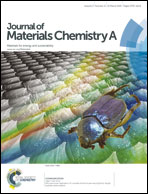Preparation of porous silicon/carbon microspheres as high performance anode materials for lithium ion batteries
Abstract
We report the preparation of porous silicon/carbon microspheres (GPSCMs) by the ball milling and spray drying methods followed by carbonization and chemical vapor deposition processes, in which, the waste fine graphitized needle coke and silicon nanoparticles were employed as the carbon and silicon sources respectively, and sucrose as the binder. The samples were characterized by X-ray diffraction, transmission electron microscopy, scanning electron microscopy, nitrogen adsorption, thermogravimetric analysis, and Raman spectroscopy. It was found that GPSCMs had spherical sizes of 8–30 μm and surface areas between 20 and 90 m2 g−1. When used as the anode materials for lithium ion batteries, the average charge capacity was 589 mA h g−1 at a current density of 50 mA g−1, much higher than that of the commercial graphite microspheres (GMs). Furthermore, GPSCMs exhibited much better rate performance than the commercial GMs, making them promising for use as the next generation anode materials in lithium ion batteries.


 Please wait while we load your content...
Please wait while we load your content...